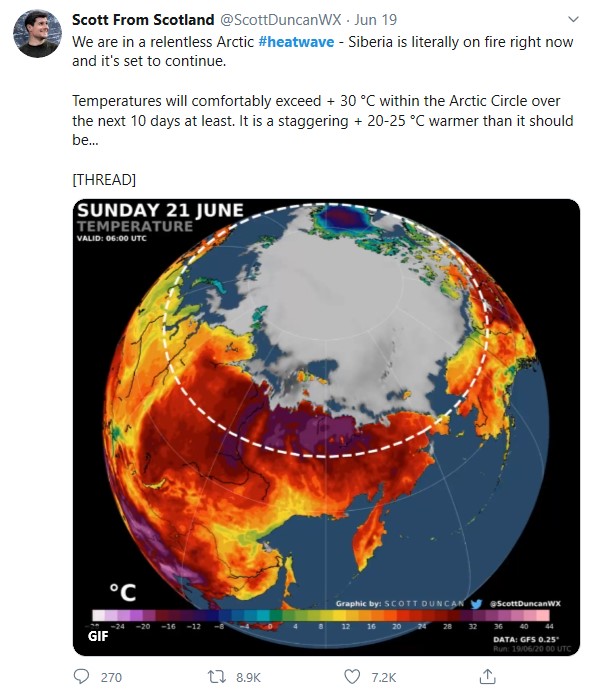Over the past few days, the news media, social media, and even the Drudge Report have been overheating about a 100-degree temperature reading in Siberia. For example, a trending tweet, below, claims Siberia is “literally on fire”:

Prominent climate activist Bill McKibben, founder of the climate activist organization, 350.org, tweeted on the 100-degree temperature recorded in Verkhoyansk Siberia:
“Siberian town tops 100 degrees F, the hottest temperature ever recorded north of the Arctic Circle. This scares me, I have to say.”
He’s scared? Well, what about the other times when it got that hot above the Arctic circle, before “climate change” became a social justice cause?
For example, this Associated Press article says “…it was 100 degrees on June 27, 1915, in Fort Yukon, [Alaska] according to official records of the National Weather Service. Records date back to 1904.”
That pretty much cools down Bill’s claim of “the hottest temperature ever recorded north of the Arctic Circle”. Both Verkhoyansk, Siberia and Fort Yukon, Alaska are well above the latitude that defines the Arctic Circle. How is it that 105 years of global warming ago, when “climate change” wasn’t even a factor, that it got that hot? Inquiring minds want to know.
Or how about the fact that the 100-degree reading in Verkhoyansk, Siberia, this week topped Verkhoyansk’s previous record (37.3C / 99.1F) by just 1 degree? Verkhoyansk’s previous record was set back in the 1980s, more than 30 years of global warming ago.
Climate activists spreading alarm about Siberian summer temperatures are ignoring that the geography and meteorological patterns of Siberia make Siberia prone to both cold winters and hot summers. Verkhoyansk has an extreme climate dominated much of the year by high pressure. This has the effect of cutting off the region from moderating temperature factors and facilitating long stretches with little cloud cover. In the winter, this leads to extensive cold. In the summer, the opposite is true, leading to very high temperatures.
According to the Moscow Times:
“Verkhoyansk holds the Guinness World Record for the highest recorded temperature range of 105 C, fluctuating from minus 68 C to a high of 37 C. The previous temperature record for the isolated town of around 1,300 residents stood at 37.3 C [99.1F] in July 1988.”
In other words, such extremes are normal for this place. With only 100 years of temperature records there, and the planet being billions of years old, it isn’t at all surprising that we still haven’t measured the extremes of natural variation, both hot and cold, for Siberia.


















Why’s there a photo of Woodrow Wilson?
It was just as warm in the Arctic Circle 100 years of global warming ago, during the Woodrow Wilson administration. : )
Alarmist love short term timelines as they always start their graphs from the end of the little ice age where temperature will naturally go up.
They do not like climate history because it shows the climatic fluctuations showing that the planet is still within the band of natural variability.
That’s why they try to either rewrite or eliminate climatic history, so they can say that the climatic fluctuations we have today are unprecedented which if you look back in time they are not.
By the way, the extreme heat in Siberia may not necessarily be a sign of global warming, but rather one of global cooling. This is because the polar vortex is being profoundly disturbed at the moment – a symptom of the world cooling (not to say that it is). Hence, up near the Arctic, whilst cold air has been descending, due to the rupture of the tight, high-pressure circulation of cold air, hot air has also been ascending. As a result, the two have been mixing, meaning that there have been small pockets of extreme heat, like in Siberia, along with pockets of extreme cold (i.e, Scotland, Sweden, Norway, etc.).
Anthony, would you have any interest in sharing information about my new book: Climate Change: A Convenient Truth? If you are interested send me an email and I will send you some information. Thanks Jim Hollingsworth jimhollingsworth@frontier.com
[…] climate) event, but we also pointed out that such extremes are normal for the region. For example, a warmer, 100-degree F temperature was reported above the Arctic Circle over 100 years ago, before “climate change” ever became a cause. Here’s another interesting note about the […]
[…] climate) event, but we also pointed out that such extremes are normal for the region. For example, a warmer, 100-degree F temperature was reported above the Arctic Circle over 100 years ago, before “climate change” ever became a cause. Here’s another interesting note about the […]
[…] circle are not historically unusual, and neither, the data shows, are heat waves. In a recent Climate Realism article, meteorologist and Heartland Institute senior fellow Anthony Watts references a 2013 Associated […]
[…] a recent Climate Realism article, meteorologist and Heartland Institute senior fellow Anthony Watts references a 2013 Associated […]